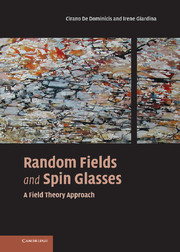Book contents
- Frontmatter
- Contents
- Preface
- List of abbreviations
- 1 A brief introduction
- 2 The Random Field Ising Model
- 3 The dynamical approach
- 4 The p = 2 spherical model
- 5 Mean field spin glasses: one-step RSB
- 6 The Sherrington–Kirkpatrick Model
- 7 Mean field via TAP equations
- 8 Spin glass above D = 6
- 9 Propagators, mostly replicon
- 10 Ward–Takahashi Identities and Goldstone modes
- 11 Alternative approaches and conclusions
- Appendix A Renormalization at one loop: ϕ4 theory (pure Ising)
- Appendix B Renormalization at one loop: tr ϕ3 theory (spin glass)
- Index
9 - Propagators, mostly replicon
Published online by Cambridge University Press: 21 October 2009
- Frontmatter
- Contents
- Preface
- List of abbreviations
- 1 A brief introduction
- 2 The Random Field Ising Model
- 3 The dynamical approach
- 4 The p = 2 spherical model
- 5 Mean field spin glasses: one-step RSB
- 6 The Sherrington–Kirkpatrick Model
- 7 Mean field via TAP equations
- 8 Spin glass above D = 6
- 9 Propagators, mostly replicon
- 10 Ward–Takahashi Identities and Goldstone modes
- 11 Alternative approaches and conclusions
- Appendix A Renormalization at one loop: ϕ4 theory (pure Ising)
- Appendix B Renormalization at one loop: tr ϕ3 theory (spin glass)
- Index
Summary
In the previous chapter we have started to look at the difficult task of inverting the Gaussian fluctuation matrix around a Parisi-like RSB equilibrium Qab. As we have seen, the core of the difficulty is manifest in the unitarity equations (8.27). In Section 8.4 we have shown that in the near infrared regime these equations become linearly coupled equations that can easily be solved to get the propagators. In general, however, the unitarity equations contain nontrivial integrals over replica overlaps (see Eq. (8.37)). To overcome this problem and solve the equations in full generality one resorts once again to the technique of the Replica Fourier Transform. This is what we shall do in this chapter. Even if the complete resolution of the unitarity equations is beyond the scope of this book, we wish at least to compute explicitly the propagators in the most dangerous replicon sector, giving a few hints on what can be done for the other sectors. With this aim in mind, we proceed in the following way. In Section 9.1 we return to the RFT technique which was used in Chapter 6 to diagonalize the Hessian (in the absence of RSB) and we generalize it for R steps of RSB. We exhibit how it works on a simple toy model and in Section 9.2 we use it to obtain the propagators in the replicon sector.
- Type
- Chapter
- Information
- Random Fields and Spin GlassesA Field Theory Approach, pp. 159 - 182Publisher: Cambridge University PressPrint publication year: 2006

